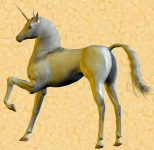

|
Beauty, Magic, Mystery Gentleness and Purity Dwells in Me |
It sounds like such an easy question. It's just a horse with a horn.
Isn't it?
No. It's considerably more than that.
For a start, the concept of a Unicorn being horse-like in appearence is quite new to us. In history he has appeared as being goat-like, deer-like, or a horned lion. In the lands of the East he looks almost like a dragon. Going further back, we see Marco Polo confusing him with a rhinocerous, and further still, Pliny the Elder describes a monster with the feet of an elephant and the tail of a boar.
Well, okay, Marco Polo had the wrong creature, and Pliny had been inhaling too much poppy smoke. Still, there is patently some variation in appearence. So what is a Unicorn?
Well, they all have one horn. That is after all what "Unicorn" means: Unus, one, and Cornu, a horn.
Is a Unicorn simply any creature with one horn then?
There are those who might agree with that statement. But throughout humankind's history, the Unicorn has always been more than simply an animal with one horn. It is a symbol. A symbol of what? Well, pretty much every positive virtue really. Harmony, strength, purity, innocence, speed, freedom, beauty, grace, magic, wisdom.
There are Unicorn legends all around the globe: Africa, India, Russia, China and Japan, Europe, and pre-and-post colonial America. It varies in stature, proportion and ability, and yet many of the legends are linked by common themes. The single, spiral horn; the Unicorn's primacy amongst all creatures; its virtue.
Today we know many variations in the Unicorn's form. He may have cloven or solid hooves. His body may be that of a deer, or a bull, or a goat, or equine. Sometimes he has the tail of a horse: at other times that of a lion. He may have the legs of a deer, a horse, or a goat. He may be white in colour, in which case it is a purity of the colour virtually unknown elsewhere, but he may equally well be black, or gold, or indigo, or of many colours. His horn, the alicorn, may be straight, or curved back, spiraled simply as a Narwhal's tooth, or in a more complex goat-like curl. The horns of the Chinese K'i-lin and the Japanese Kirin frequently had several forward-growing tines.
Just as his appearance may vary, so does his role in the world: sometimes he is simply a beautiful animal. At other times he has an intelligence at least on a par with our own, and is famed for his gentle wisdom. Often he is a creature of divinity, pure of heart and spirit beyond any mortal's reach, possessed of incredible powers of creation and healing. In China he is a creature of good omen, appearing to those destined for greatness: the mother of the philosopher Confucius was one such. In ancient Japan he appeared as a celestial judge, slaying the guilty and freeing the innocent. The Christian faith holds him as a symbol of Jesus Christ.
Fantasy has added to the range of his aspects, though the image of the equine Unicorn predominates. There are those who maintain that modern fiction has no right to shape the creatures of classical mythology, but there is one quality the Unicorn always embodies: freedom. Not just from physical confinement, but definition; defying the restrictions of classifications and categorisation. Humankind has always sought to catch and hold him, with chains, in tapestries, by word. The story-tellers of today have just as much -or as little- right to try and capture him.
The Unicorn is special among the creatures of legend. He is at one and the same time both real and imaginary, a creature of the past and present; solid and intangible; animal and deity; an immortal power and yet with a child-like vulnerability.
Many are wary of saying he never existed.
A surprising number are wary of saying he doesn't exist now.


